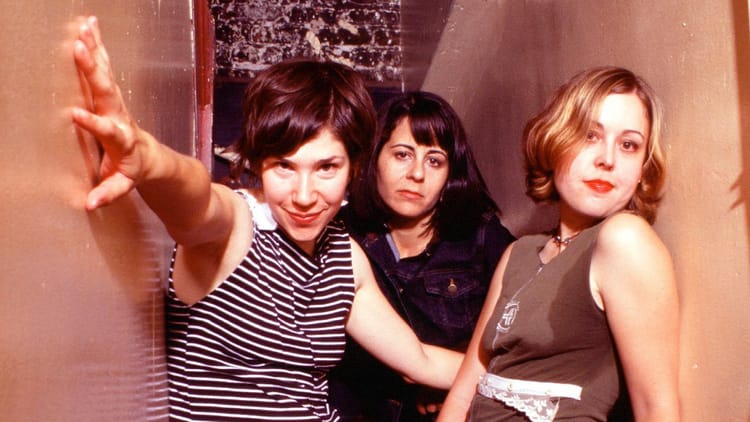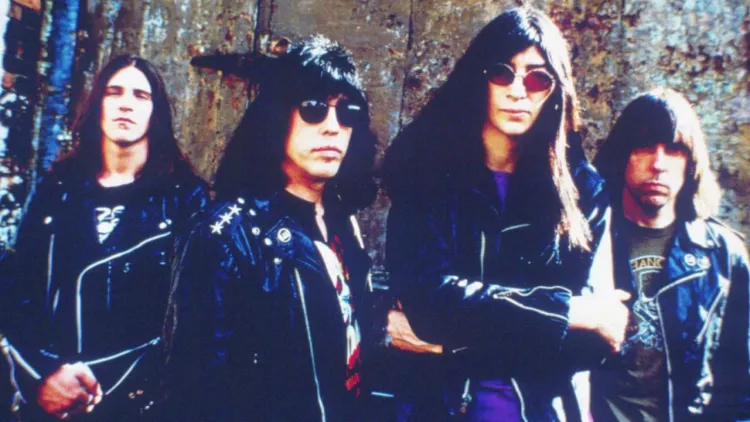The Cure, pt. 1: Anthony's Album Guide

GLIB XENNIAL CONTENT WARNING: If you are above the age of forty and resent critical commentary about treasured new wave cassettes from your adolescence, proceed with caution and humor. Remember, this author gave R.E.M.’s Green a 9. His handy dandy profoundly subjective numerical rating scheme is decoded here. Part 2 is here.
Three Imaginary Boys (1979) 6
Boys Don’t Cry (1980) 7
Seventeen Seconds (1980) 8
Faith (1981) 9
Pornography (1982) 9
Japanese Whispers (1983) 7
The Top (1984) 6
The Head On The Door (1985) 5
Standing On A Beach: The Singles (1986) 8
Kiss Me, Kiss Me, Kiss Me (1987) 8
Thanks to generations of rock bands whining in their wake - several subgenres’ worth - it’s hard to appreciate how novel The Cure was at first. Not just in the realm of popular rock, but in the post-punk new wave that birthed them. Where Joy Division bucked and fought against depression, The Cure sulked for the sake of sulking, reveling in bad moods and upset tummies. Early 4AD acts like Bauhaus and The Birthday Party wanted everyone know how sexy and/or violent they could be, but The Cure was always aggrieved, elated or ashamed in matters of the flesh, almost never the aggressor. For all their sensitivity, Depeche Mode wanted somebody who would not just care, but could keep up with their stylish, decadent ways. The Cure never suggested they were cooler than anyone, except maybe people who thought they were cool. They reveled in the physical sensation of vices - good and bad - rather than the artifice. Bandleader Robert Smith came into the world unapologetically grumpy and weird; his anguish inchoate when it wasn’t transparently melodramatic, his sudden bursts of whimsy & rapture equally extreme. Where Nick Cave could sneer “whaddya got?” if asked what he was shrieking for, Smith would sigh “oh, everything” and hide in his sweater. For many elders, they were the most insufferable of the proto-Goths because they made the least effort to explicate their stance. Ironically, this gave them an enormous, enduring appeal to the young, as schoolkids can rarely can explain their mood swings either, beyond needing someone to say they love them forever and ever and ever.
The Cure's first video...would you look at these babies? So many bad days ahead of them...
Like most Americans, I didn’t hear their UK debut Three Imaginary Boys until well after I heard Boys Don’t Cry, a revamp that adds the band’s first three singles and removes such dubious deep cuts as an instrumental named “The Weedy Burton” and a cover of “Foxy Lady” sung by the bassist. The trio, schoolmates in bands long before punk happened, but not too rigid to embrace the new sounds, waffles between such influences as Wire, The Buzzcocks and The Stranglers. Despite their audible youth and uncertainty, they occasionally hit the pop-rock nail on the head: “Boys Don’t Cry” and “10:15 Saturday Night” are immortal pouts of romantic regret, while slower numbers like “Three Imaginary Boys” and “Another Day” show then-surprising psychedelic promise. But mostly they sound like a band that lost the high school talent show because an English teacher didn’t like their sneering. While that English teacher would appreciate the Camus reference of “Killing An Arab,” their first single, they picked the worst possible verb-noun pairing from The Stranger to make a title, something humanist-when-not-nihilist Smith has wrestled with ever since.
By Seventeen Seconds, released just two months after Boys Don’t Cry, Smith had filled in with spiritual older siblings Siouxsie & The Banshees on tour, hired a keyboardist, fired the guy who sang “Foxy Lady,” and realized exactly what kind of post-punk he wanted to make: dreamy late ‘60s psych-folk like Pink Floyd & Nick Drake, with the Teutonic synth-gloom of Berlin-era Bowie. Musically, he got impressively close. Vocally, Smith sounded like a snotty teenager mocking you for never having heard Nick Drake, before grumbling into his beer because you said Low was worse than Ziggy Stardust. Faith doubled down on the slow strums, sadness and synth-drum thwacks, Smith firing the keyboardist and playing it himself so nobody could say the parts were too basic & funereal. Each album featured one danceable single (first “A Forest,” about getting lost in one, then “Primary,” a bass-bass-drums number that thankfully doesn't sound too much like Spinal Tap’s “Big Bottom” sped up), and lots of drunken sobbing about hating everything except old books. I can’t get enough of this vibe, with Faith in particular a magisterial walk through the cemetery, grappling with intense emotions Smith only thinks he understands. I even like the outtake “Carnage Visors,” a thirty-minute instrumental jam they played under a short film in place of an opening act. A cassette release of Faith included “Visors” as the B side, which sounds like a goth makeout classic if there ever was one.
If Dad thought they needed a haircut in '79...get a load of '82!
Easily the biggest - if not only - thing bringing money to Fiction Records, run by manager Chris Parry, Faith was mostly written in the studio due to their busy touring schedule. High on drugs and low on everything else, Smith knew something had to change. But first he and the band (bassist Simon Gallup and drummer Lol Tolhurst) wanted to puke out all their bad mojo on record for posterity. I don’t know if they wanted to show competing pouters how it’s done, or just vent spleen while aping the pummel of the first Psychedelic Furs album (Smith an avowed fan). But they sure as fuck won the goth gold with Pornography. The album is all body-bruising binges, bad trips and a morbid fascination with being absolutely miserable and out of your skull. The most effusive lyrical agony and the flangiest guitars over the most cavernous drums. My least favorite song is the single, too lyrically repetitive compared to the deliciously overwrought jabber around it (I have a similar beef with the preceding stand-alone “Charlotte Sometimes”).
For the first time, though certainly not the last, Smith assumed the band was dunzo after one last hellscape of a tour, where Smith first experimented with big hair and smeared lipstick, Gallup quitting after a bar fight. Smith detoxed and rejoined Siouxsie & The Banshees, happy to be a mere sideman. He might have stayed there if Pornography wasn’t the band’s first UK Top 10, and Chris Parry wasn’t desperately trying to keep his biggest cash cow alive. In either a brilliant bit of A&R brinksmanship or a desperate hail-mary pass, Parry asked Smith and Tolhurst to record a jaunty jingle and call it The Cure, the pair struck by the perversity of the idea. “Let’s Go To Bed,” coming out just half a year after Pornography, was a goofy trifle, with Tolhurst switching from drums to keyboard. Smith was still unimpressed by the “stupid game” of human, particularly sexual, interaction, but audibly tickled to be making synth-pop out of it. They even asked Soft Cell’s video director Tim Pope to help them learn how to frolic on screen. And, surprise! They were great at it!
One year had passed. One year.
While still playing with the Banshees and acting diffident about The Cure’s future, more singles followed in 1983. “The Walk,” a truly shameless rewrite of New Order’s “Blue Monday,” became the band’s first Top 20 UK single. “The Lovecats,” a horn-festooned(!) valentine(!!) where Smith revealed his gift for enthusiastic scatting(!!!) was their first Top 10. The three As & five of the Bs were combined for a mini-album named Japanese Whispers, the Bs featuring just enough gloom and flange to keep most old fans from bailing. Smith also recorded an album of synthed-up psychedelica with Banshees bassist Steve Severin and singer Jeanette Landray as The Glove that year, concurrently beginning work on new Banshees and Cure albums. Which is naturally what you do when you’re a loudly fatigued rock star struggling to stay sober.
1984’s The Top is often treated like utter, negligible chaos, but it’s less transitional than gestative: a blueprint for what The Cure would sound like once it was a band again (while Tolhurst and drummer Andy Anderson played on The Top, touring bassist Phil Thornally didn’t and new guitarist Pearl Thompson only contributes saxophone). Smith’s Jimi Hendrix influence had never been more present, from the hard rock swagger of “Shake Dog Shake” to sighing “Oh, I should feel like…a polar bear” over a flamenco lick while praising a “Birdmad Girl.” “Give Me It” is as chaotic a clatter as what’s on Pornography, but now our hero is demanding rather than overwhelmed. “Slit the cats like cheese/ then eat the sweet, sticky things/ suck harder!” - my dude!
If you told Robert Smith in 1984 that he'd still have this look forty years later...
I don’t need anything on the B of The Top after the fluttery effervescence of “The Caterpillar,” whose video had Smith combining his big 1982 hair and his pale 1983 make-up with a billowing button-down shirt, a look that made The Cure the most immediately recognizable weirdo rock band since Devo. But I still prefer the album slightly over The Head On The Door, their 1985 follow-up and American breakthrough. Thompson was fully incorporated as the band’s first “lead” guitarist, with Simon Gallup back on bass and the drum seat now filled by a beautifully busy beast of a metronome named Boris Williams (Tolhurst playing keyboards, at least in theory). The album peaks with heavenly tributes to New Order and Psychedelic Furs, singles so romantic and confident those bands were probably left seething with jealousy. But the rest of the album is another jumble of arty anguish, orientalism and staid synth presets, more spare and professional than The Top, but so what. In a remarkable bit of foreshadowing, the most enjoyable of the album tracks is both the last & the longest. I’ve docked Door a point because I cannot stand to hear “Close To Me” without the single mix’s ecstatic dueling saxophone & trumpet solos. Never deny this Lovecat his horns!
Standing On A Beach: The Singles (or Staring At The Sea, depending on your format of choice) does a terrific job of capturing The Cure at their most radio-ready and whimsical. Bookended by pop peaks from Boys Don’t Cry and The Head On The Door (including that single mix of “Close To Me”!), the compilation creates a narrative where the band’s goth phase was a trudging nadir rather than a howling apex. While this tragically kept me from checking out Faith and Pornography until adulthood, I can’t stay mad. Besides, future generations found out the truth anyway.
A scene from The Cure Goes To Monte Carlo (1987).
Though a singles collection often means a band’s best days are behind them, The Cure - thanks to this larger, now road-tested line-up - finally found their AOR crossover metier on Kiss Me, Kiss Me, Kiss Me, their best album in years despite being a double. Smith allowed the other members to have more input in the songwriting, allowing for such quirks as the frenzied strum duel on “Shiver and Shake,” and “Catch,” a romantic reverie so delicate you might miss that Williams is subtly going off on his kit. Eighteen tracks of manic depression, veering from giddy synth-soul workouts like “Hot Hot Hot!!!” And “Hey You!!!” (yes, those exclamation points are in the titles!!!) to spacey mopes like “All I Want” and “One More Time” is a lot, but perfect with three forced breathers on vinyl. MTV, happy to show young America this spooky sweetheart who mugged endlessly to the camera while rarely looking right at at it, helped “Just Like Heaven” crack the US Top 40. While it only reached #40, its legacy grew much larger over the years, piano and guitar solos gingerly dancing around each other as Smith wistfully describes morts both petit and grand, splitting the difference between Joy Division’s “Love Will Tear Us Apart” and “Summer Nights” from Grease.
Up next in Part 2: Decades 2-4 and albums 8-13, as the band gets even bigger and considerably less busy.
Pornography is at 199 on My Top 300 Favorite Albums of All Time. Had I revisited Faith a little earlier, it would have been a dozen or so spots below it. I'm telling you this because I've found people are more inclined to discuss and share reviews if there's a quantitative element at the top or bottom they can easily debate. Prove me right! Direct correspondence, however, can be shipped off to anthonyisright at gmail dot com.




